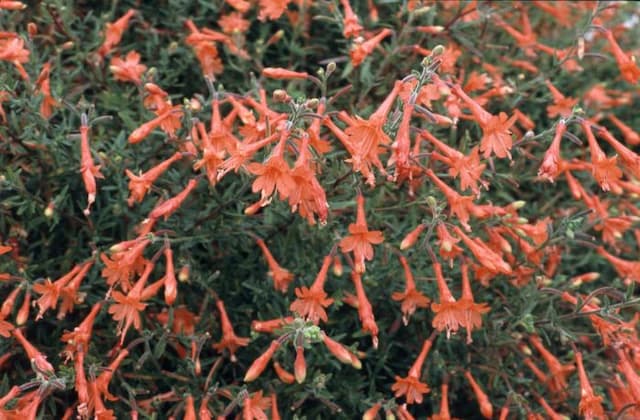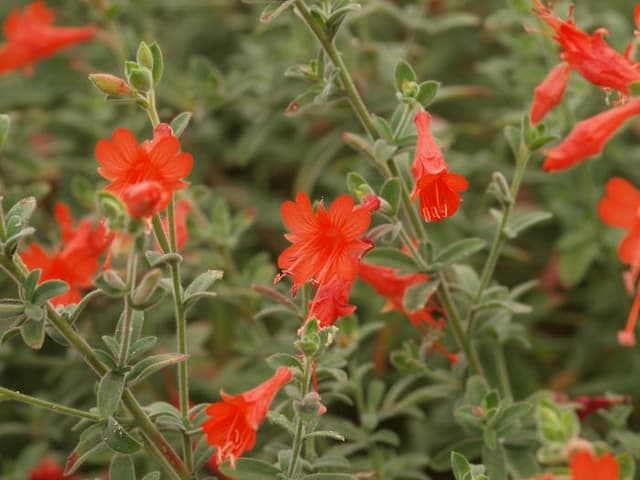Fuchsia Fuchsia 'Beverley'

ABOUT
Fuchsia 'Beverley' is known for its striking appearance, with elegant, pendulous flowers that are highly decorative. The blooms typically display a beautiful contrast of colors, having a two-tone palette. The outer petals, called the sepals, are usually long and slender, often colored in a delicate pink or sometimes a brighter shade like magenta. Inwardly, they give way to a softer, inner skirt of petals, known as the corolla, which often showcases a deeper purple or violet tone, creating an eye-catching display. The foliage of Fuchsia 'Beverley' adds to its charm, with leaves that have a soft, green hue. The leaves are oval-shaped with a slight point at the tip and are arranged oppositely along the stems, creating a bushy and lush appearance. The stems, from which the flowers hang, may be trailing or upright, depending on how the plant is grown and supported. Overall, the plant's appearance is one of graceful drooping flowers and vibrant colors, combined with a lush green backdrop provided by its foliage. This combination makes Fuchsia 'Beverley' a popular choice for gardeners looking to add a touch of elegance and vivid color to their garden displays.
About this plant
 Names
NamesSynonyms
Lady's Eardrops, Fuchsia, Hardy Fuchsia, Hanging Fuchsia
Common names
Fuchsia 'Beverley'.
 Toxicity
ToxicityTo humans
Fuchsia 'Beverley', commonly known as fuchsia, is generally considered non-toxic to humans. Therefore, ingestion of parts of this plant typically does not result in poisoning or serious health consequences. However, individual sensitivities vary, and consuming non-edible plants is not advisable. If accidental ingestion happens and symptoms do appear, it would be wise to consult a healthcare professional.
To pets
Fuchsia 'Beverley', commonly referred to as fuchsia, is not known to be toxic to pets. It is typically safe for dogs, cats, and horses, and ingestion usually does not cause harm or result in serious illness. Nonetheless, eating non-food plants can sometimes lead to gastrointestinal upset in pets. If any symptoms arise after ingestion, such as vomiting or diarrhea, it is recommended to contact a veterinarian.
 Characteristics
CharacteristicsLife cycle
Perennials
Foliage type
Deciduous
Color of leaves
Green
Flower color
Pink
Height
2 feet 4 inches (72 cm)
Spread
2 feet 4 inches (72 cm)
Plant type
Shrub
Hardiness zones
9
Native area
Central and South America
Benefits
 General Benefits
General Benefits- Aesthetic Appeal: Fuchsia 'Beverley' has attractive flowers with vibrant colors and elegant, drooping petals that enhance the beauty of gardens and outdoor spaces.
- Habitat for Wildlife: The flowers of the fuchsia plant provide a source of nectar for hummingbirds, bees, and other pollinators, supporting local biodiversity.
- Versatility: Fuchsias can be grown in a variety of settings including hanging baskets, containers, and borders, making them suitable for different garden designs.
- Shade Tolerance: Fuchsia 'Beverley' can tolerate partial shade, making it a great choice for garden spots that don't receive full sun.
- Long Blooming Season: Fuchsias often bloom from late spring to fall, providing a lengthy display of flowers throughout the growing season.
- Ease of Propagation: Fuchsia plants can be easily propagated from cuttings, allowing gardeners to create more plants affordably and sustainably.
 Medical Properties
Medical PropertiesThis plant is not used for medical purposes.
 Air-purifying Qualities
Air-purifying QualitiesThis plant is not specifically known for air purifying qualities.
 Other Uses
Other Uses- As a natural dye: The vibrant flowers of the Fuchsia can be used to create natural dyes for textiles or crafting projects.
- Inked inspiration: Artists may use the Fuchsia's striking appearance as inspiration for botanical illustrations or tattoo designs.
- Culinary garnish: Edible Fuchsia flowers can add a pop of color and a slightly tangy taste to salads and desserts.
- Photography subject: The beautiful blossoms make the Fuchsia plant a popular subject for photographers, especially for macro photography.
- Creative crafts: The colorful flowers can be used in creating decorative wreaths or incorporated into pressed flower art.
- Learning tool: Fuchsia plants can serve as an educational resource for horticulture students learning about plant care and propagation.
- Eco-friendly confetti: Dried, crushed Fuchsia petals can be used as biodegradable confetti for outdoor celebrations.
- Feng Shui: In the practice of Feng Shui, placing a Fuchsia plant in certain areas of the home is believed to bring positive energy.
- Jewelry making: The unique shape and vibrant colors of Fuchsia flowers make them an interesting addition to botanical resin jewelry.
- Container gardening: Growing Fuchsia 'Beverley' in hanging baskets or decorative pots can enhance small urban spaces like balconies.
Interesting Facts
 Feng Shui
Feng ShuiThe Fuchsia is not used in Feng Shui practice.
 Zodiac Sign Compitability
Zodiac Sign CompitabilityThe Fuchsia is not used in astrology practice.
 Plant Symbolism
Plant Symbolism- Confidence: Fuchsia plants, with their vivid colors and elegant shape, often symbolize confidence and self-assuredness, encouraging individuals to trust their abilities.
- Elegance and Grace: The delicate teardrop shape and the graceful way the flowers hang off the stems reflect sophistication and poise.
- Good Taste: The unique and attractive appearance of Fuchsia 'Beverley' suggests a sense of good taste and appreciation for beauty and quality.
- Overflowing Abundance: The prolific blooming nature of the plant signifies a cornucopia of joy, ideas, and creativity.
 Water
WaterThe Lady's Eardrops should be watered thoroughly, allowing the moisture to reach deep into the roots, but ensuring that the plant does not remain waterlogged. Water the Fuchsia 'Beverley' when the top inch of soil feels dry, which may be about once or twice a week, depending on environmental conditions. During the growing season, usually from spring to fall, it will require more frequent watering, possibly every 2-3 days. Use approximately 16-24 ounces of water for potted specimens each time you water. During winter, reduce watering to once every 1-2 weeks, being cautious of overwatering.
 Light
LightLady's Eardrops thrive best in bright, indirect sunlight. A spot that receives morning sunlight with dappled afternoon shade is ideal. Avoid placing your Fuchsia 'Beverley' in the harsh afternoon sun, which can scorch the foliage, and also keep it away from deep shade, which can impede its blooming.
 Temperature
TemperatureThe Lady's Eardrops prefers consistently cool to moderate temperatures, thriving ideally between 55-75 degrees Fahrenheit. It can survive temporarily outside this range, but temperatures below 40 degrees or above 80 degrees Fahrenheit can stress the plant. Providing good air circulation without putting the plant in the way of cold drafts or hot vents will help maintain the optimal temperature conditions.
 Pruning
PruningPruning Lady's Eardrops is essential for maintaining its shape, encouraging bushy growth, and stimulating the production of more flowers. Prune in late winter or early spring before new growth begins, removing dead or weak stems and shaping the plant. Pruning can be done again lightly throughout the summer to remove spent flowers and seed pods, which encourages continued blooming.
 Cleaning
CleaningAs needed
 Soil
SoilThe best soil mix for Fuchsia 'Beverley' is loose, well-draining, and rich in organic matter. Aim for a pH range between 6.0 and 7.0. A mix containing peat moss, perlite, and compost is ideal for providing the necessary nutrients and drainage.
 Repotting
RepottingFuchsia 'Beverley' should be repotted every 2 to 3 years or when it outgrows its current container. It's best to repot in the spring before new growth begins.
 Humidity & Misting
Humidity & MistingFuchsia 'Beverley' thrives in high humidity conditions, ideally between 60-70%. Consistently moist air without being overly wet is key for their growth.
 Suitable locations
Suitable locationsIndoor
Place in bright, indirect light and ensure high humidity for Fuchsia 'Beverley'.
Outdoor
Hang in partial shade, shelter from wind, and maintain moist soil for Fuchsia 'Beverley'.
Hardiness zone
9-11 USDA
 Life cycle
Life cycleFuchsia 'Beverley', commonly known simply as fuchsia, begins its life cycle as a seed, which upon germination, sprouts to produce a small seedling with a few leaves. As the seedling matures, it develops a rooting system and a woody stem, growing into a young plant with more substantial foliage and the characteristic drooping flowers for which fuchsias are known. During its flowering stage, it attracts pollinators with its brightly colored petals, leading to pollination and the subsequent formation of berries that contain seeds for the next generation. After flowering, if the environmental conditions are not ideal, the plant may enter a dormant phase, particularly in colder climates, where it loses its leaves and conserves energy. With the return of favorable conditions, the fuchsia resumes growth, producing new shoots, leaves, and flowers to continue its cycle. This cycle may repeat annually for several years as a perennial, with the plant increasing in size and the number of blooms with each growing season.
 Propogation
PropogationPropogation time
Spring-Early Summer
Propogation: Fuchsia 'Beverley' is commonly propagated through softwood cuttings, a method best performed in late spring or early summer. To propagate using this method, a healthy, non-flowering shoot is selected from the parent plant. A cutting, about 2 to 4 inches (approximately 5-10 cm) long, is taken just below a leaf node, and the lower leaves are removed. The bare stem is typically dipped in rooting hormone powder to encourage root development and is then inserted into a pot filled with a moistened mixture of peat and perlite. The pot is covered with a plastic bag to maintain high humidity, which is crucial for successful rooting, and placed in a warm, bright location out of direct sunlight. Roots usually form within a few weeks, after which the new Fuchsia 'Beverley' plant can be gradually acclimatized to less humid conditions before eventual planting out.









